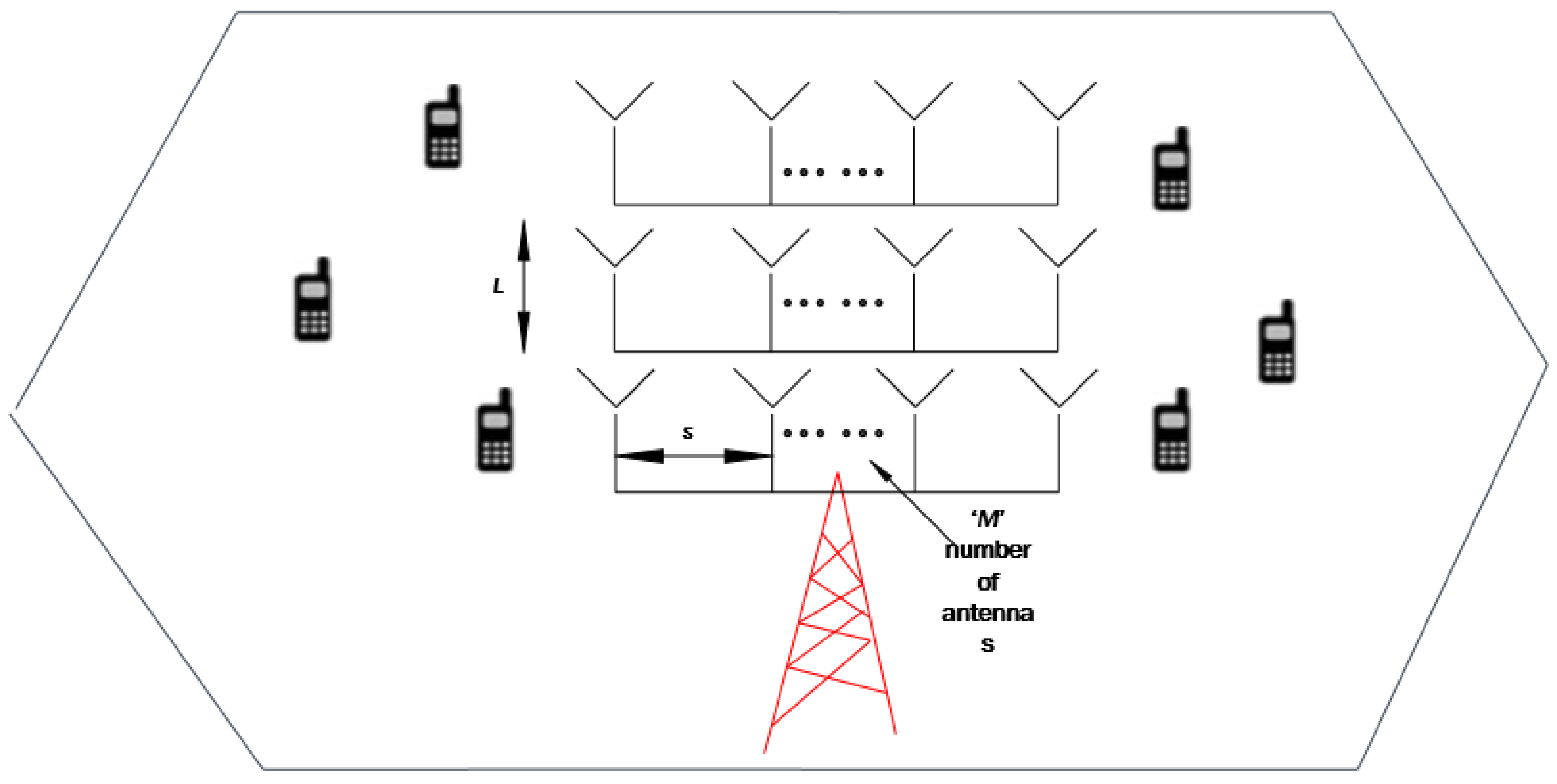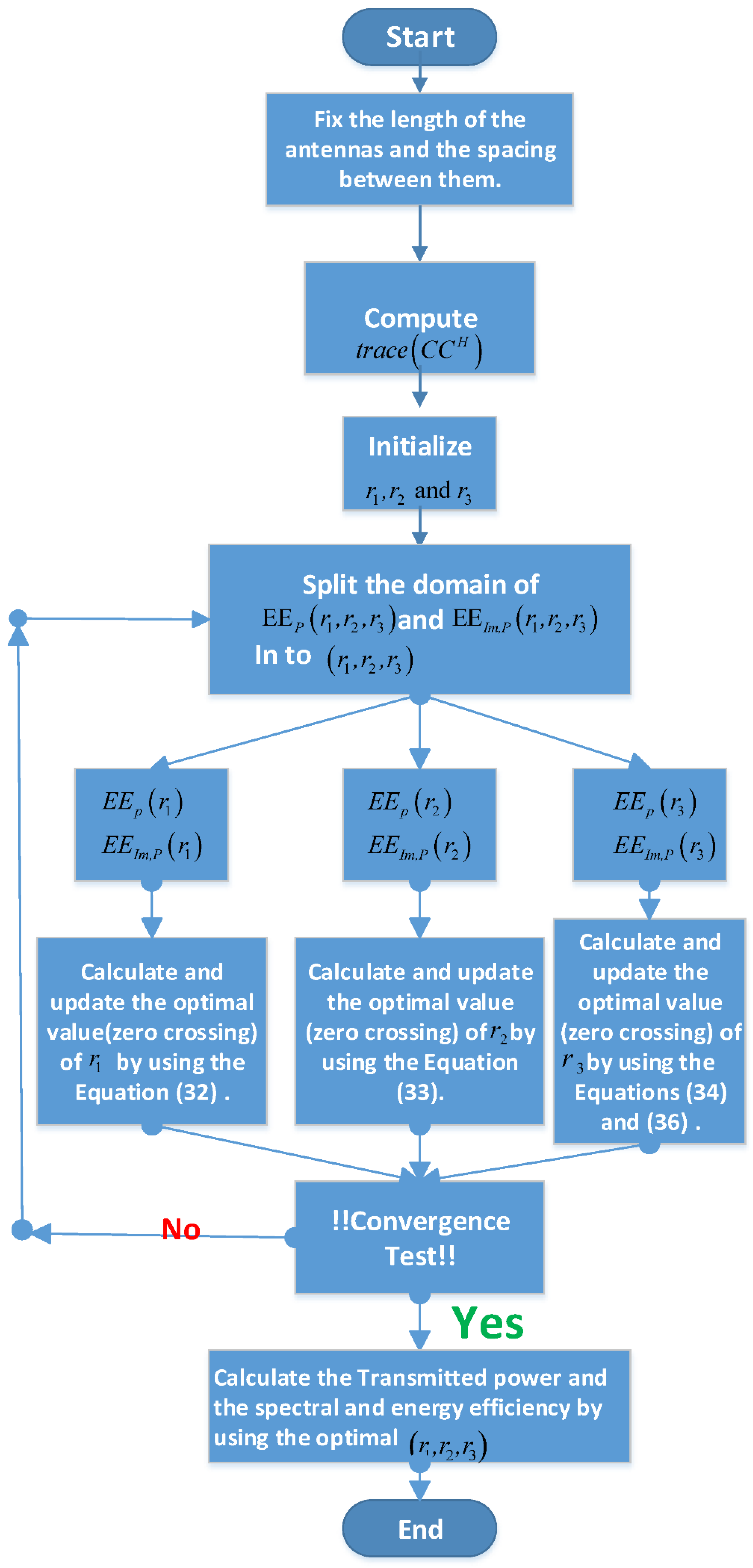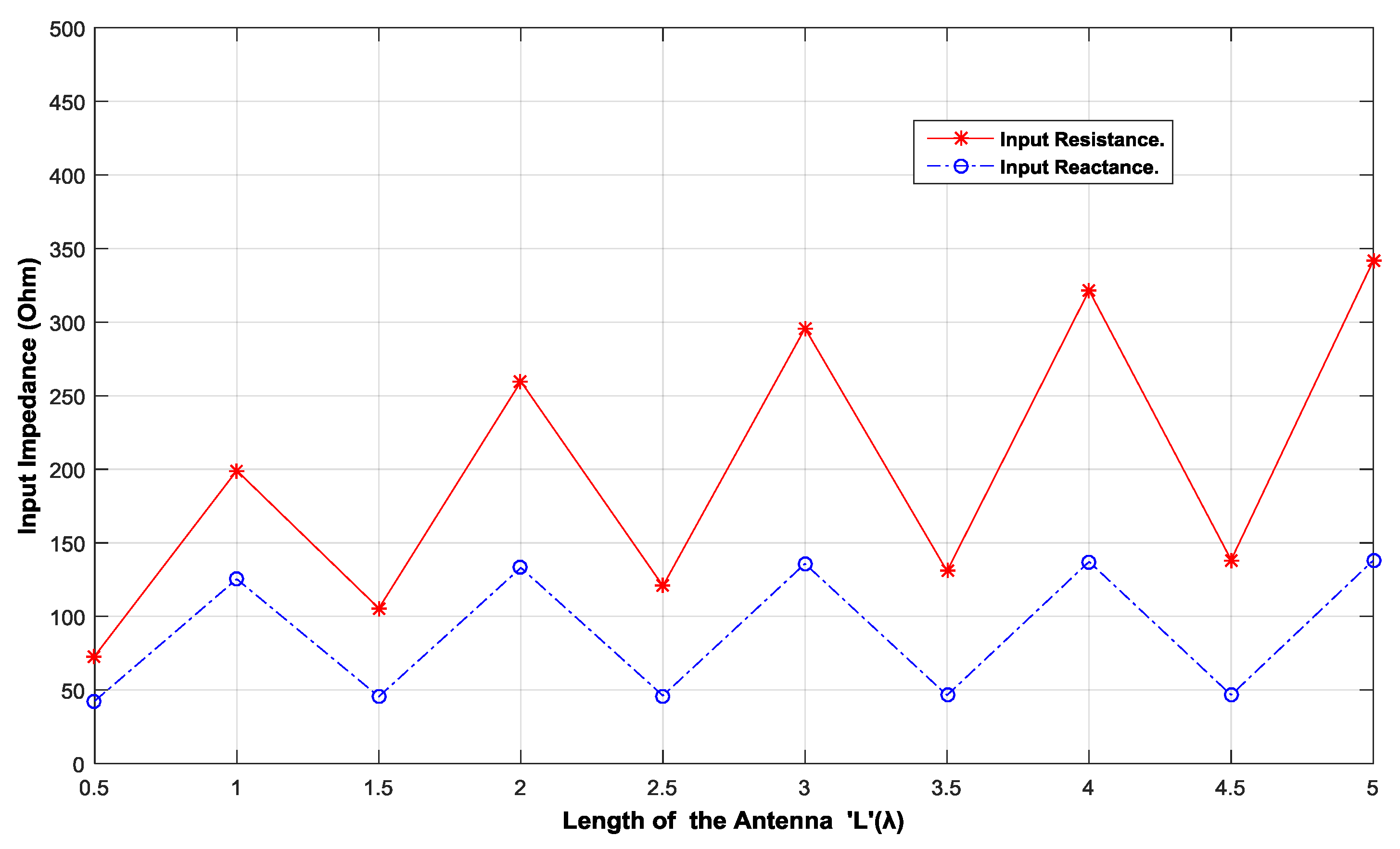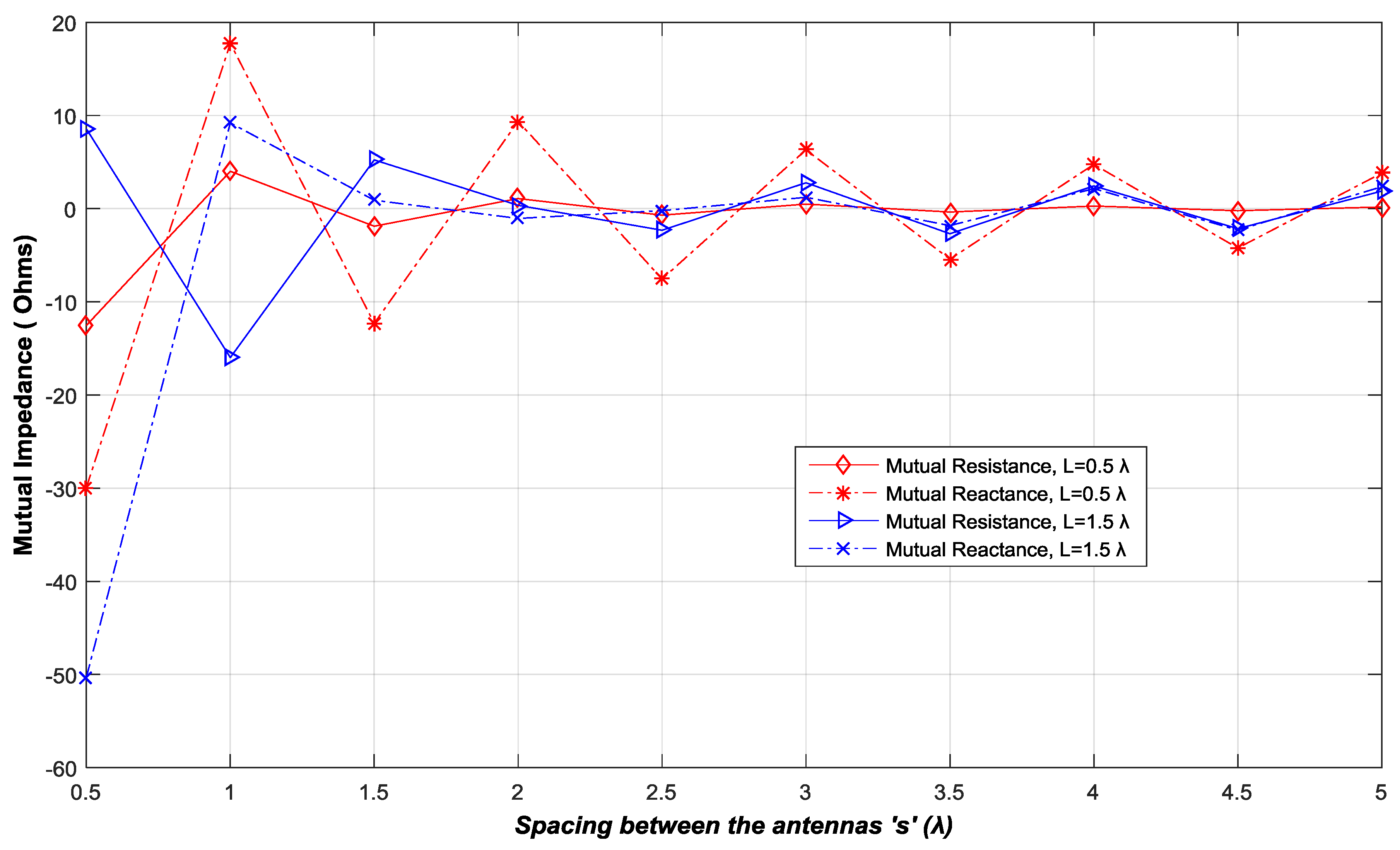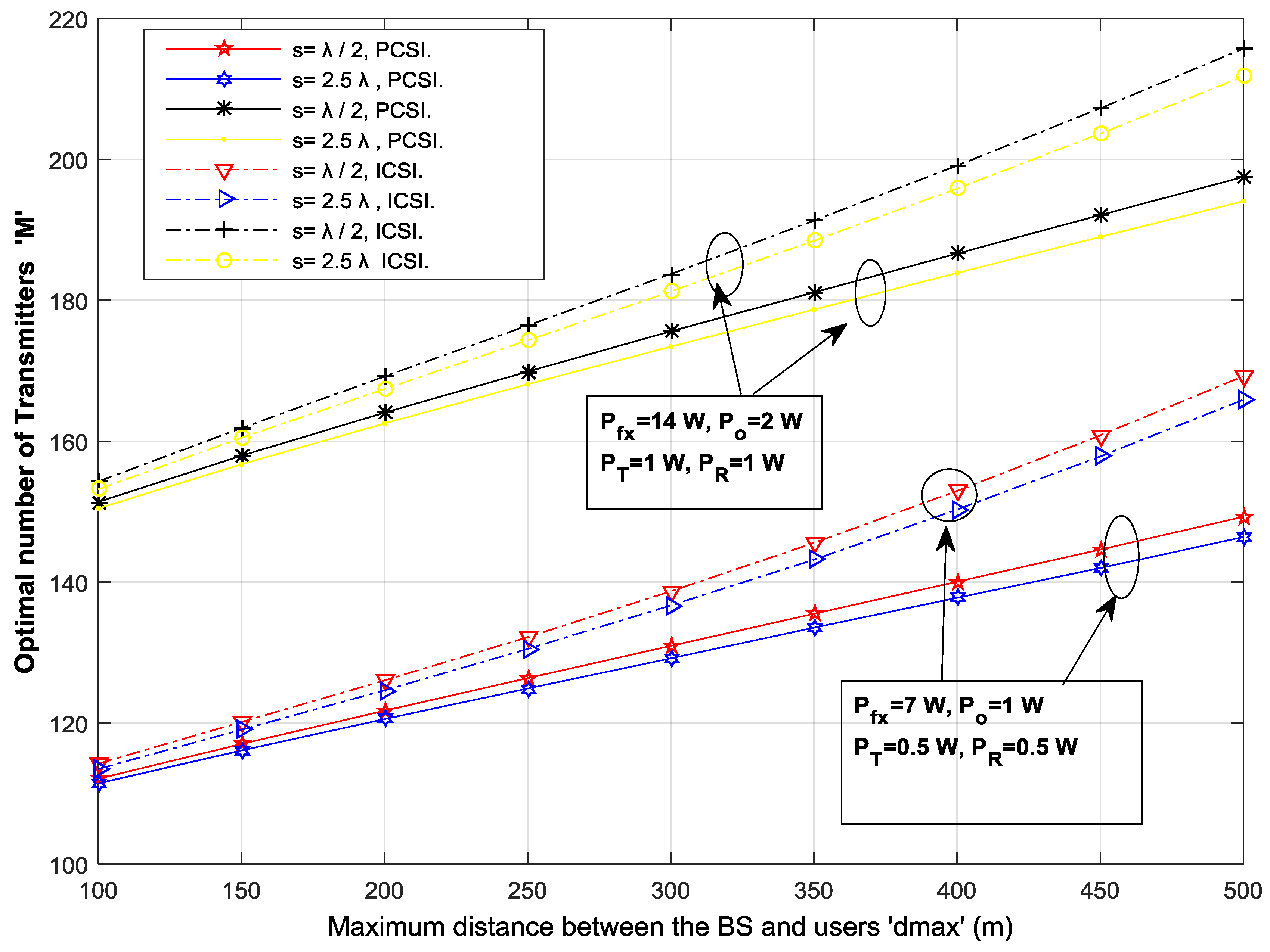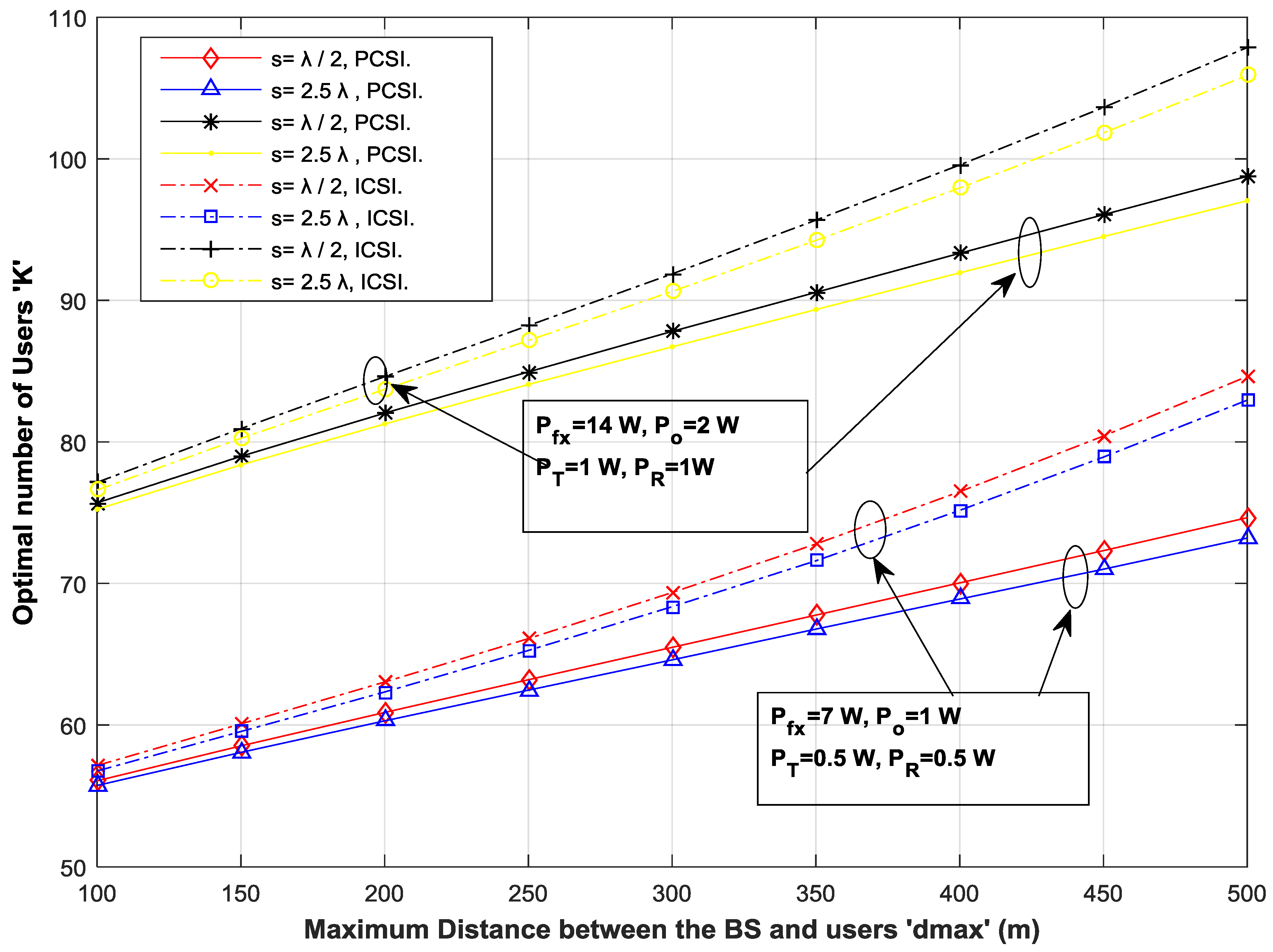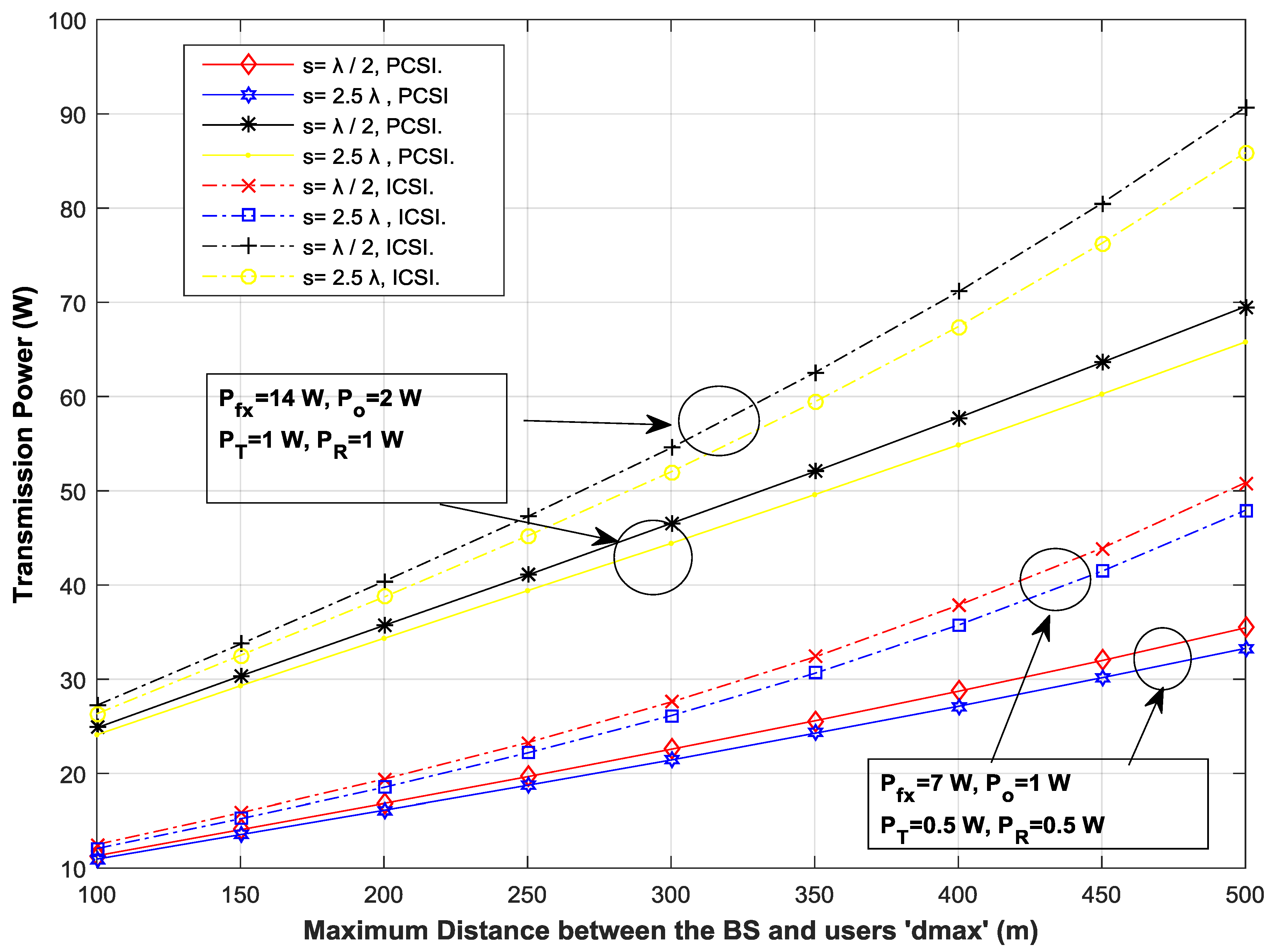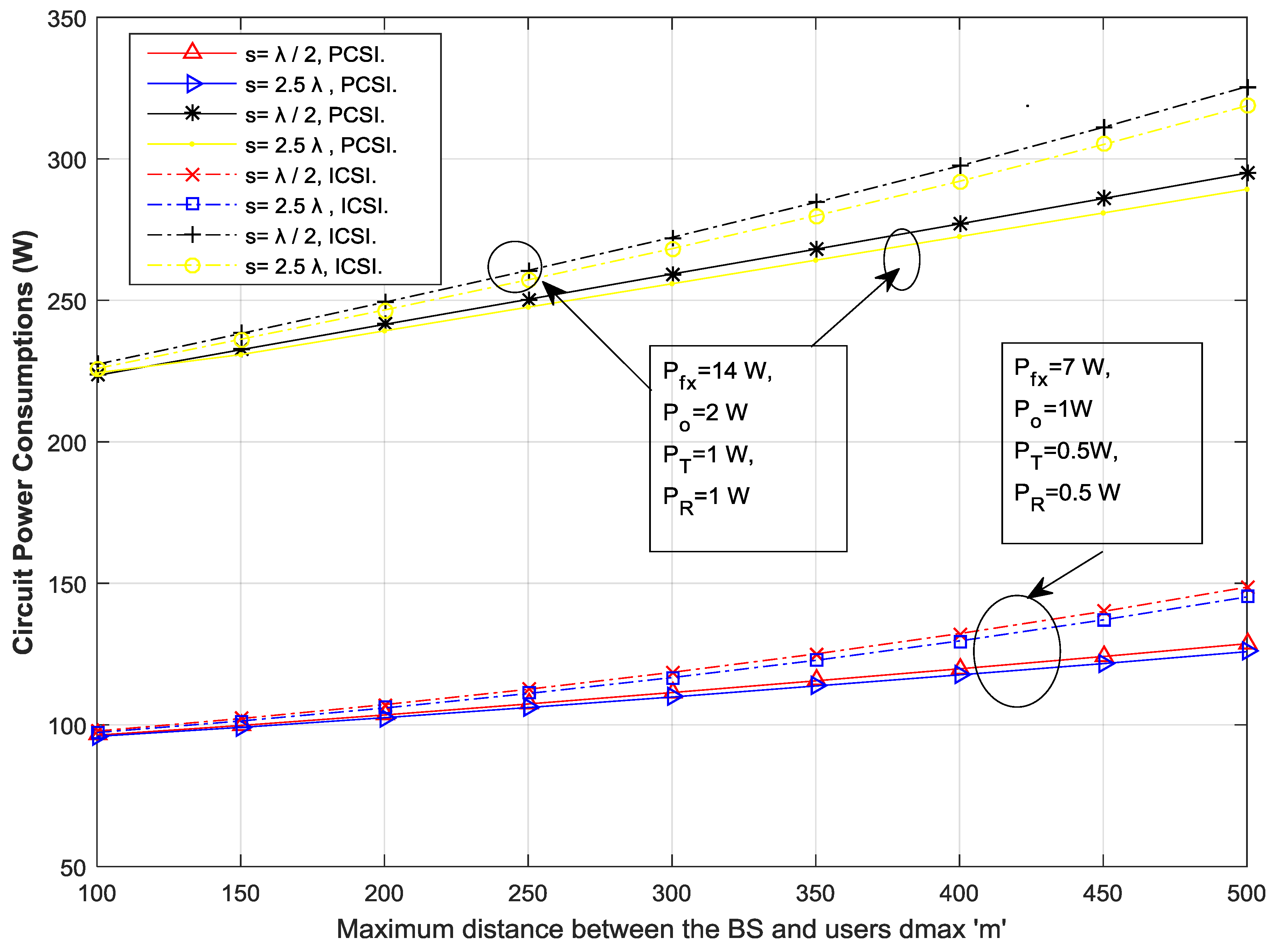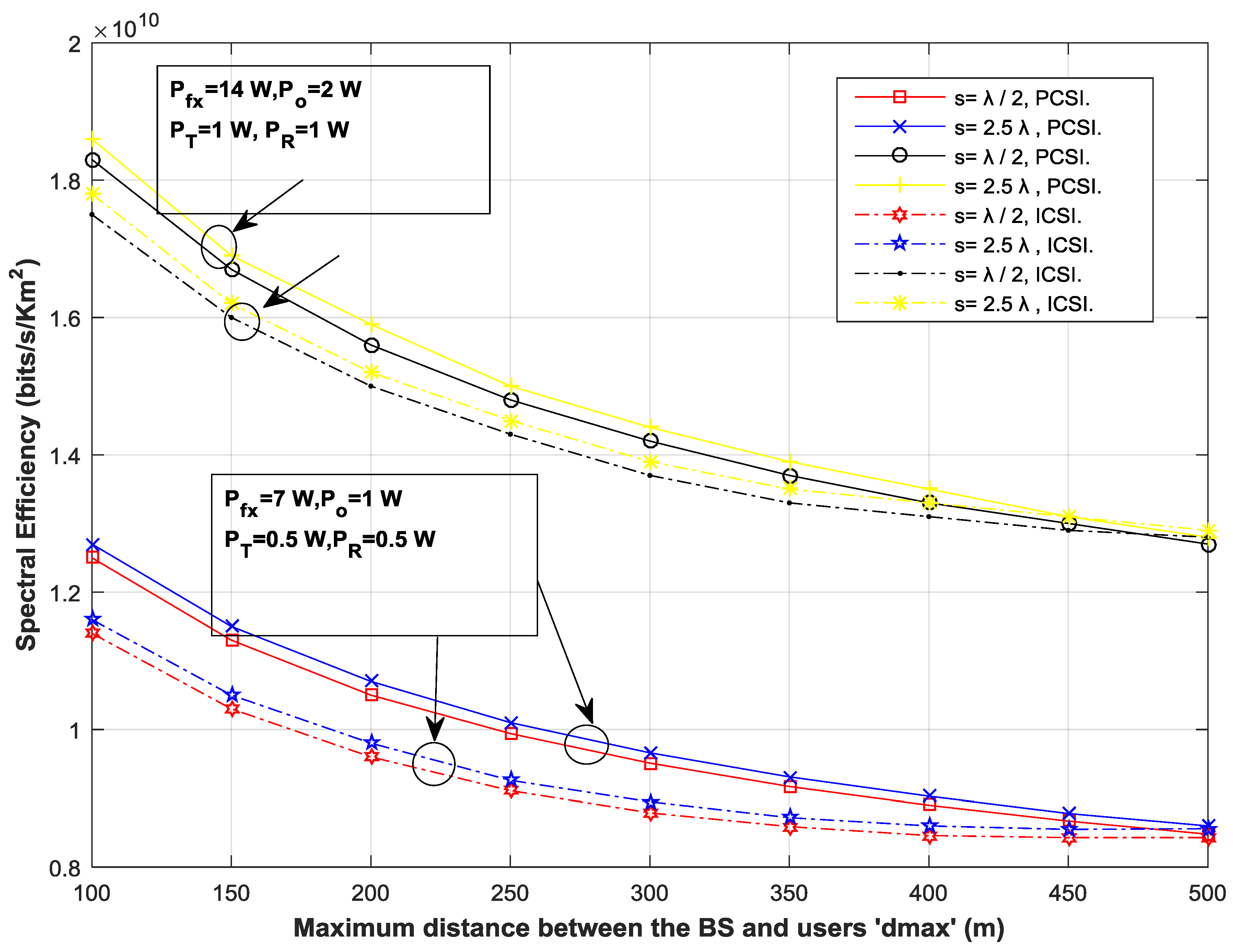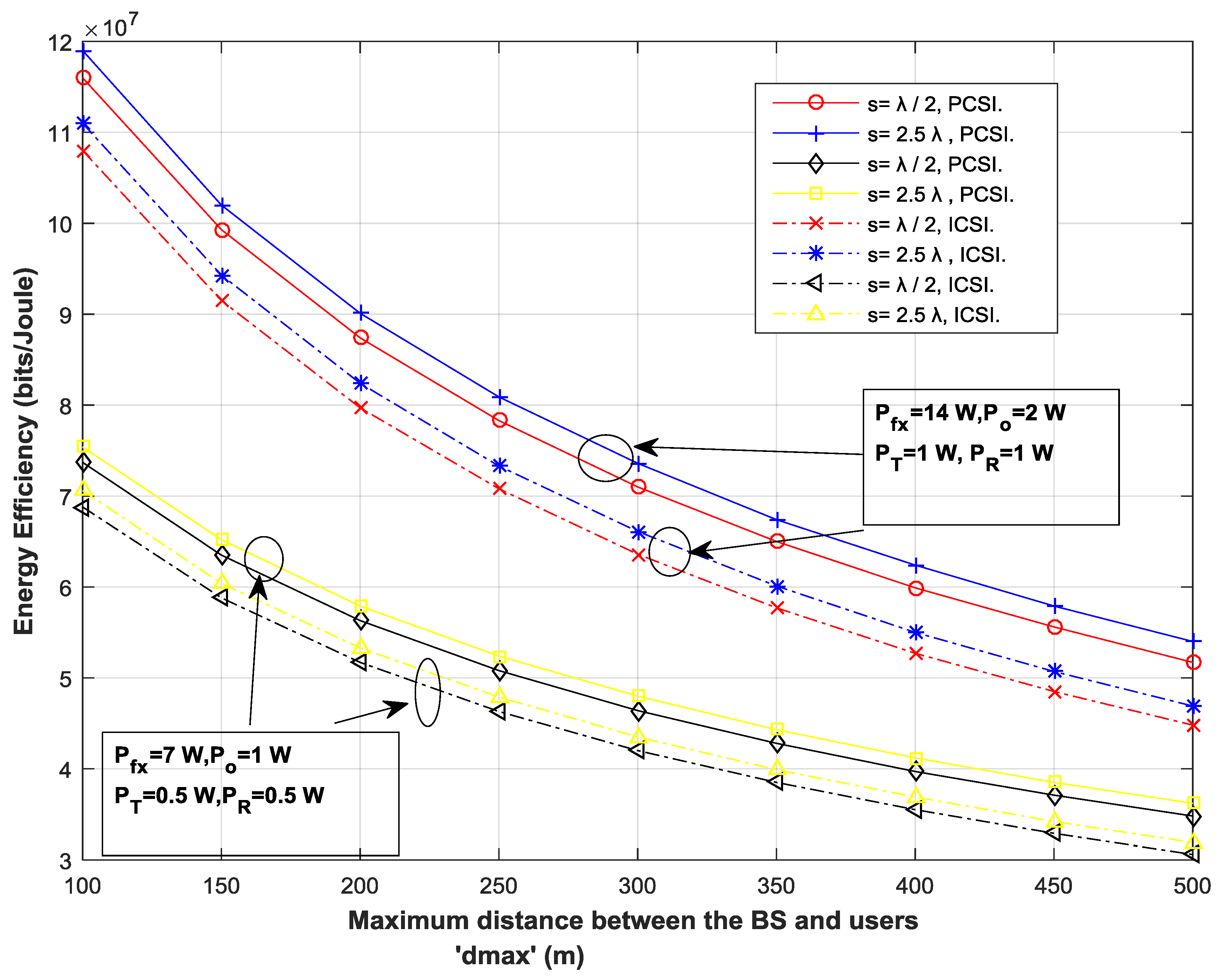1. Introduction
Wireless communication is the most vital and key technology in this modern era and with the ever-increasing trend of advances in the wireless technologies, a large number of users are using these technologies, which in turn require having a network with higher energy and spectral efficiency together with the simple signal processing [
1,
2,
3]. Multiple Input Multiple Output (MIMO) systems have gained a lot of attraction, both in industry and academia, due to their ability to significantly improve the spectral efficiency, but the acquisition of higher spectral efficiency comes at the cost of complex computation and signal processing in the conventional MIMO systems [
4]. Massive MIMO can significantly increase the performance of the system by just adopting the linear precoding and decoding schemes for the downlink transmission and the uplink reception due to the asymptotic orthogonality of the propagation channel, as compared to the conventional MIMO systems [
5,
6,
7,
8].
In Massive MIMO, hundreds of antennas have to be stationed on the top of a building or tower, serving a comparatively less number of users [
9,
10]. In the urban environment, the electromagnetic interaction between the antenna elements is inevitable due to the space limitations for the deployment of a large number of antenna elements at the base station, thereby, leads to a phenomena named Mutual Coupling [
11]. In [
12,
13], the authors have investigated the mutual coupling effect on the performance of the conventional MIMO systems by calculating the closed-form expression of the channel capacity, based on closely spaced antenna elements. In [
14], the authors have examined and investigated the new challenges and issues regarding the deployment of hundreds of antenna elements at the Base Station (BS). In [
15,
16], the authors have modeled the channel and derived the closed-form expression of the channel by considering the effect of mutual coupling among the antenna terminals of Massive MIMO. The mutual coupling effect can be minimized by using the hardware-circuit calibration method and the signal-space calibration method [
17,
18,
19]. The theory and benefits of the Massive MIMO are also applicable for the scenario of the wireless sensor networks where each sensor node can be taken as the user and the fusion center is equipped with large number of antennas, leading into the favorable propagation between the sensor nodes and the fusion center [
20,
21]. The initial focus of the researchers was on the spectral efficiency and the channel capacity of the communication devices, but the energy and power related pollution and the inevitable battery depletion of the wireless devices shifted the focus of the researchers to have more and more research on the green cellular networks in order to conserve as much energy as possible [
2].
The energy efficiency is significantly dependent on the number of transceiver chains, transmitted and the consumed power [
22,
23]. The power consumption of the conventional MIMO systems is always taken as a fixed quantity due to the limited number of transmitter chains [
24]. However, this assumption is not valid for the Massive MIMO, because the circuit power consumption is significantly dependent on the number of transmitter chains. The number of transceiver chains required for the system can be reduced by using the hybrid analogue to digital transceivers. In [
25], the authors evaluate the performance of hybrid analogue to digital precoders by modelling the power consumptions of the RF chains. Motivated by the above research [
25], the authors in [
26,
27] work on the energy efficient designing of the hybrid analogue to digital transceivers for the single carrier in [
26] and for the single and multi-carrier large antenna arrays in [
27] for the perfect channel conditions. In [
28], the authors have investigated the energy and spectral efficiency of Massive MIMO at different channel situations and showed that the large number of antenna elements at the base station can significantly enhance the energy efficiency with orders of magnitude compared to the conventional MIMO systems, but, they fixed the total power consumption of the circuit, which in turn let them have an unbounded energy efficiency. In [
29], the authors have investigated the energy efficiency and calculated the capacity limits of Massive MIMO, but the authors have not modelled the power consumption of the circuit in a correct way. They have not taken the power consumption during the decoding and coding, channel estimation and the linear processing, which in turn let them have the substantial enhancement in the energy efficiency. In [
30,
31,
32], the authors have investigated the tendency of the energy efficiency with respect to the increase in the number of transmitting antennas, users and the transmitted power, and showed that the energy efficiency depicts the response of quasi concave function in terms of the number of transmitting antennas in [
30], and in terms of the number of users and the transmitted power in [
31,
32] respectively, by using the refined and appropriate model of the total circuit power consumption. Motivated by the above researches [
30,
31,
32], the authors in [
33] extended the results under different channel conditions, by using the refined and correct model of the total circuit power consumption.
In the corpus of the researches [
22,
23,
24,
25,
26,
27,
28,
29,
30,
31,
32,
33], the authors have optimized and investigated the energy efficiency along with the computation of different optimal system parameters, by taking the assumption that the transmitting antennas at the BS are spaced enough, in order to nullify the effect of mutual coupling among the antenna elements. This assumption is not correct for the massive MIMO wireless communication systems, especially under the scenario of the urban environment, due to the space limitations for the deployment of a large number of antenna elements at the base station. Therefore, the effect of mutual coupling is inevitable among the antenna elements for Massive MIMO wireless communication systems. In [
34], the authors have optimized the energy efficiency and computed the optimal transmitting antennas and users by considering the effect of mutual coupling between the antenna elements at the BS under the perfect channel situation.
In this article, we have derived and formulated the mathematical expressions of the achievable spectral efficiency along with the energy efficiency by taking the effect of mutual coupling between the transmitting antennas at the base station with respect to the different channel conditions. We have designed the energy efficient Massive MIMO by using the correct model of the circuit power consumption and computed the number of optimal user terminals, transmitting antennas and the corresponding consumed as well as the transmitted power. Mutual coupling effect among the antenna elements have been thoroughly investigated on the energy efficiency and other optimal parameters, by varying the length of the transmitting antennas and the spacing between them. The optimization problem of energy efficiency has been formulated in order to calculate the optimal parameters with respect to the different channel conditions. We have proposal a domain splitter algorithm for the optimization of energy efficiency, and calculation of the optimal parameters. A detailed comparison is presented between the reference and the proposed algorithms in terms of the computation complexity. At the end, we have made simulations in order to support and show the effectiveness of the mathematical modelling, where the simulation result shows the optimally achieving energy efficiency and other optimal system parameters, with respect to different channel conditions and the spacing between the antenna elements.
This article is further arranged as follows. First, we have modelled the channel and derived the spectral efficiency of the Massive MIMO, by taking the effect of mutual coupling among the antenna elements, with respect to the different channel situations in
Section 2. Next, we have modelled the circuit power consumption of massive MIMO in
Section 3. Furthermore, we have formulated the optimization problem of energy efficiency in
Section 4. In
Section 5, the domain splitter algorithm and the complexity comparison are presented between the proposed and the reference algorithms. The simulation results are provided in
Section 6.
Section 7 belongs to the conclusion where we summarize and conclude all the discussions.
The notation used in this paper is as follows:, , , , and denotes the inverse, cosine integral, transpose, sine integral, conjugate, and the Hermitian operator respectively, , denotes the expectation and the norm operation, denotes the positive integers, and denotes the logarithm of x with respect to base 2 and , , denotes the first order derivative and the second order derivatives, , denotes the approximation and the variance notation, denotes the complex normal distribution with mean x and the variance y. Additionally, represents the matrix trace operation.
2. Channel Modelling and the Spectral Efficiency
In Massive MIMO, hundreds of antennas have to be stationed on the top of a building or tower, serving comparatively small number of users. Time Division Duplex is the most desirable scheme in the case of Massive MIMO, because of the reciprocity between the uplink and downlink channels during each coherence block, as compared to Frequency Division Duplex (FDD), where pilot overhead in each coherence block is dependent on the number of transmitting antennas at the BS. In FDD, we have to use different frequencies in the uplink and downlink and the pilot overhead of the channel estimation is proportional to the number of transmitting antennas, leading to a very challenging situation at the user terminals to acquire the downlink channel state information and then feedback the acquired channel state information to the base station. The Massive MIMO was basically imagined for TDD protocol, but can be applied also in FDD by using the various techniques.
Figure 1 unveils the frame sequence in the case of TDD protocol, the Channel State Information C.S.I at the BS can be estimated with the help of Uplink training signals or pilots for
channel uses and the estimated C.S.I can be exploited during the downlink transmission for
channel uses. The performance of the massive MIMO relies critically on the correctness of the C.S.I during each coherence block
U.
Consider the
number of the dipole antennas are equipped at the BS, having the length
and separated by a distance
, serving
number of uniformly distributed single antenna users as can be seen in
Figure 2. Therefore, the received signal at the base station can be written as:
where
is the matrix of the transmitted signals from the
number of uniformly distributed single antenna users and
is the received signal matrix with the dimension of
at the base station.
can be deemed as the average transmitted power and
is the Additive White Guassian Noise with the dimension of
and has the zero mean and unity variance, whereas
is the channel matrix with the dimension of
.
Massive MIMO can enhance the performance by exploiting the orthogonality between the channels of the desired and the interference signals, which in turn results into the communication reliability, by using the linear signal processing during the uplink transmission and the downlink reception. Thus, the linear precoding matrix
can be written as:
As explained earlier, the transmitting antennas at the base station are closely spaced, leading into the effect of mutual coupling. Thus, the channel matrix by considering the mutual coupling effect among the base station antennas can be expressed as:
where
is the mutual coupling matrix with the dimension of
and
is the Rayleigh small scale fading matrix.
is a
large scale diagonal matrix and can be written as:
where
shows the path loss or the large scale fading between the base station and the
kth user terminal. The mutual coupling matrix when the
number of the dipole antennas are equipped at the BS can be written as [
13]:
where
and
represent the load and the self-impedance respectively.
represents the matrix of mutual impedance, where the diagonal entries showing the self-impedances of the transmitting antennas, and, the non-diagonal entries are showing the mutual impedances. The mutual impedance between two particular transmitting dipole antennas
i and
j can be written as [
35]:
where:
where
is the distance between two antenna terminals and
is the length of the dipole antenna element as shown in
Figure 2.
represent the cosine and sine integrals respectively and can be written as:
Assume that, the zero forcing linear detection scheme is implemented at the base station, then, the signal received at the base station can be expressed as:
Similarly, the signal received from the
kth user terminal can be written as:
where
represent the
kth column of the detection matrix
V and the equivalent noise
can be expressed as:
. The Signal to Noise Ratio (S.N.R) at the corresponding
kth link can be expressed as:
As we know
. Thus, the above equation can be written as:
The corresponding achievable rate can be illustrated as:
Theorem 1. In Rayleigh fading channel, whenand ZF detector is implemented at the base station, then, the achievable rate for the kth user terminal can be written as: The overall spectral efficiency (
) for the total
K number of users can be written as:
Put the value of
from (7) to (8):
The overall spectral efficiency by taking the overhead of the training signals into account can be written as:
Whereas, T is the total length of the relative pilot sequence.
Computation of the Spectral Efficiency under the Scenario of Imperfect Channel Situation
The performance of the Massive MIMO is significantly dependent on the acquisition of the C.S.I. However, having a perfect (C.S.I) is almost unfeasible in terms of real-world scenario, which in turn leads to interference among the user terminals. During the uplink transmission, the C.S.I is computed by using the pilot signals, and, let the uplink power of the pilot signal for the kth user terminal be
and the total length of the orthogonal pilot signals be
as shown in
Figure 1. The estimated channel matrix
can be expressed as:
where
is the channel estimation error during the acquisition of the frequency response of propagation channel. Therefore, the signal received at the BS can be written as:
Theorem 2. In Rayleigh fading channel, whenand ZF detector is implemented at the BS, then, the achievable rate for the kth user terminal by computing the estimated channel with the help of the MMSE estimator for the imperfect channel condition can be expressed as: Similarly, the overall spectral efficiency by taking the overhead of the training signals into account for the imperfect channel conditions can be expressed as:
3. Power Consumptions
Total power consumption can be expressed as an additive summation of the overall circuit power consumption, and the transmitted or power amplifier power. We have modeled the total circuit power consumption as well as the transmitted power in this section. The total transmitted power
can be expressed as:
where
is the efficiency of the PA’s and
is the overall noise power. Assume that the users are distributed uniformly in between the minimum
and the maximum distance
, then, the total transmitted power by using the uniform distribution can be expressed as:
where
represent the path loss factor and the circuit power consumption can be written as the power consumed in the transceiver chains (
) (filters, convertors and the mixers powers), power consumption during the site cooling and maintenance
, coding and the decoding power
, linear processing power
, power consumed during the estimation of the channel
and the oscillator power
. Thus, the total power consumption can be expressed as:
The consumed power in the transceiver chains
can be written as:
where
,
represent the consumption of power at the transmitter and the user end. The power consumed during the decoding and coding of the signals is dependent on the number of bits, so, the power consumed during this process can be written as:
where
,
is the power consumption during the process of decoding and coding of the received and the transmitted signals. As explained earlier, massive MIMO relies significantly on the accurate acquisition of the frequency response, so, the timely acquisition of the frequency response is of timely important, and the consumed power during the channel estimation
can be expressed as [
34]:
where
represent the number of coherence blocks per second,
,
is the computational efficiencies at the base station and the user end during the estimation of the channel. The power consumption during the linear processing
can be interpreted as [
36]:
Thus, the overall power consumption
by using the (13)–(18) can be written as:
Thus, the total power consumption (19) by using the above given substitutions can be expressed as:
5. Computation of the Optimal Parameters and the Complexity Comparison
In this section, we have proposed and discussed the domain splitter algorithm to calculate the optimal parameters and the comparison is presented between the proposed and the reference algorithms, in terms of the computation complexity. We have named the proposed algorithm as the domain splitter algorithm because the proposed algorithm splits the domains of
and
, and then find the solution in each respective domain as shown in
Figure 3. The
and
shows the response of the quasi concave and depicts the one and the only one zero crossing at the points
and
in each respective domain
, as per the
Appendix C and
Appendix D. In the
Appendix C and
Appendix D, the solution of the energy efficiency is derived in each respective domain
and the optimal values are computed at the points
and
by using these solutions. The
Figure 3 shows the domain splitter algorithm and the simulation methodology where the optimal values of
are computed until the convergence. Finally, the acquired optimal values are used to compute the number of optimal user terminal, optimal transmitters along with the transmitted power, energy and the spectral efficiency.
Table 2 shows the computation complexity between the proposed and the reference schemes and
is the lambert omega operation. It can be seen from
Table 2 that the computational complexity of the reference algorithms is dependent on the multiplication of the number of transmitting antennas at the BS with the number of user terminals
. As Massive MIMO is dependent on the theory of large numbers of transmitting antennas at the BS, so, the computational complexity behind the reference algorithms is so high. The proposed algorithm (domain splitter algorithm) significantly improves the computation complexity where the energy efficiency gets saturated at the third iteration as shown in Figure 12.
6. Simulations
We have performed simulations in order to test and demonstrate the effectiveness of the domain splitter algorithm along with computation of different optimal system parameters.
Table 3 unveils the basic simulation parameters used for the simulations. We have used the acronyms of PCSI and ICSI for the perfect and imperfect channel state information respectively in the simulation figures.
Figure 4 unveils the input impedances by varying the length of the antenna, where the real part of the antenna impedance is showing the power that is either absorbed or radiated away and the imaginary part is showing the stored power. Input impedance depends significantly on the length of the antenna terminal, as it can be seen from
Figure 4.
Figure 5 unveils the mutual impedance between the antenna terminals with respect to the spacing among the antennas, calculated by using the (3), at different lengths of the antenna terminal.
Figure 6 unveils the total number of optimal BS antennas with respect to the maximum distance between the base station and the users, at different circuit power consumption and at different spacing among the BS antennas. When the BS antennas are closely spaced, then it leads to mutual coupling and a higher number of the transmitting antennas are required. The effect of the mutual coupling and different antenna spacing on the optimal number of transmitters under the different channel situations can be seen in
Figure 6.
When the maximum distance between the base station and the end users gets increased, then, the number of optimal BS antennas required for the system will be increased, in order to cover more distance as shown in
Figure 6. Similarly,
Figure 7 shows the optimal number of user terminals with respect to the maximum distances (100–500 m) between the BS and the users, at different circuit power consumption and at different spacing among the BS antennas. More transmitted power is required when the BS antennas are closely spaced to overcome the mutual coupling effect along with the imperfect channel conditions as shown in
Figure 8. Furthermore, high circuit power consumption leads to have more transmitted power to accommodate the higher number of BS antennas and the end users, and it is significantly dependent on the maximum distance between the BS and the users as shown in
Figure 8 and
Figure 9.
Figure 10 unveils the effect of mutual coupling on the achievable spectral efficiency of the system, and when the BS antennas are more closely spaced, then, the overall spectral efficiency gets reduced. As the system requires to have more transmitted power when the maximum distances between the BS and users gets increased, thereby, leads to have the reduction in the overall spectral efficiency of the system as shown in
Figure 10.
Similarly,
Figure 11 unveils the mutual coupling effect on the overall energy efficiency of the system with respect to the different maximum distances between the BS and the end users, and imperfect channel situation leads to have a reduction in the overall achievable energy efficiency, due to the higher consumed as well as the transmitted power.
Figure 12 unveils the computational complexity and the convergence of the proposed domain splitter algorithm, where the convergence of the energy efficiency can be examined with respect to the number of iterations. The energy efficiency goes into the saturation at the 3rd iteration, so, the computational complexity of the domain splitter algorithm in terms of Landau’s big O notation can be written as:
. A detailed comparison between the proposed and the reference algorithms in terms of computation complexity has been presented and discussed in
Table 3.

